Caribbean Sea
| Caribbean Sea | |
|---|---|
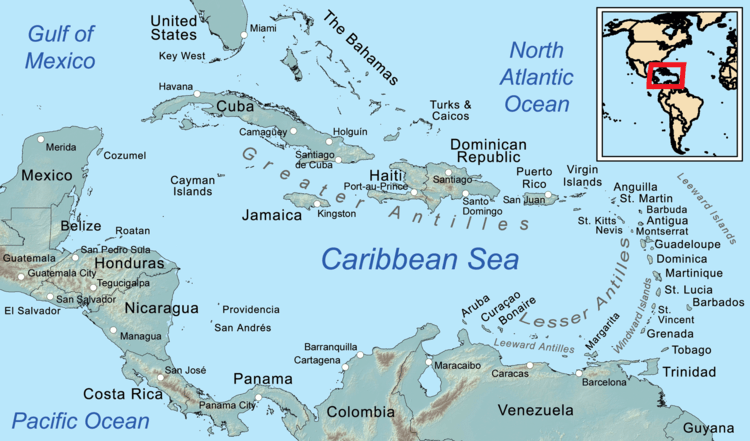 | |
| Type | Sea |
| Surface area | 2,754,000 km2 (1,063,000 sq mi) |
| Max. depth | 7,686 m (25,217 ft) |
The Caribbean Sea (Spanish: Mar Caribe French: Mer des Caraïbes Dutch: Caraïbische Zee) is a sea of the Atlantic Ocean in the tropics of the Western Hemisphere. It is bounded by Belize and Central America to the west and south west, to the north by the Greater Antilles starting with Cuba, to the east by the Lesser Antilles, and to the south by the north coast of South America.
The entire area of the Caribbean Sea, the numerous islands of the West Indies, and adjacent coasts, are collectively known as the Caribbean. The Caribbean Sea is one of the largest seas and has an area of about 2,754,000 km2 (1,063,000 sq mi).[1] The sea's deepest point is the Cayman Trough, between the Cayman Islands and Jamaica, at 7,686 m (25,220 ft) below sea level. The Caribbean coastline has many gulfs and bays: the Gulf of Gonâve, Gulf of Venezuela, Gulf of Darién, Golfo de los Mosquitos, Gulf of Paria and Gulf of Honduras.
The Caribbean Sea has the world's second biggest barrier reef, the Mesoamerican Barrier Reef. It runs 1,000 km (620 mi) along the coasts of Belize, Guatemala, and Honduras.[2]
History

The name "Caribbean" derives from the Caribs, one of the region's dominant Native American groups at the time of European contact during the late 15th century. After the discovery of America by Christopher Columbus in 1492, the Spanish term Antillas applied to the lands; stemming from this, "Sea of the Antilles" became a common alternative name for "Caribbean Sea" in various European languages. During the first century of development, Spanish dominance in the region remained undisputed.
From the 16th century, Europeans visiting the Caribbean region identified the "South Sea" (the Pacific Ocean, to the south of the isthmus of Panama) as opposed to the "North Sea" (the Caribbean Sea, to the north of the same isthmus).[3]
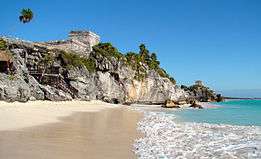
The Caribbean Sea had been unknown to the populations of Eurasia until 1492, when Christopher Columbus sailed into Caribbean waters on a quest to find a sea route to Asia. At that time the Western Hemisphere in general was unknown to Europeans. Following the discovery of the islands by Columbus, the area was quickly colonised by several Western cultures (initially Spain, then later Portugal, England, the Dutch Republic, France, Courland and Denmark). Following the colonisation of the Caribbean islands, the Caribbean Sea became a busy area for European-based marine trading and transport, and this commerce eventually attracted pirates such as Samuel Bellamy and Blackbeard. (See Piracy in the Caribbean)
Due to the abundance of sunshine, year-round tropical temperatures moderated by the almost constant trade winds and the great variety of scenic destinations to visit, during the second half of the 20th century and on into the 21st the Caribbean Sea became a popular place for tourism.

As of 2015 the area is home to 22 island territories and borders 12 continental countries.
Extent
The International Hydrographic Organization defines the limits of the Caribbean Sea as follows:[4]
- On the North. In the Windward Channel - a line joining Caleta Point (74°15'W) and Pearl Point (19°40'N) in Haïti. In the Mona Passage - a line joining Cape Engano and the extreme of Agujereada (18°31′N 67°08′W / 18.517°N 67.133°W) in Puerto Rico.

- Eastern limits. From Point San Diego (Puerto Rico) Northward along the meridian thereof (65°39'W) to the 100 fathom line, thence Eastward and Southward, in such a manner that all islands, shoals and narrow waters of the Lesser Antilles are included in the Caribbean Sea as far as Galera Point (Northeast extremity of the island of Trinidad). From Galera Point through Trinidad to Galeota Point (Southeast extreme) and thence to Baja Point (9°32′N 61°0′W / 9.533°N 61.000°W) in Venezuela.
Note that, although Barbados is an island on the same continental shelf, it is considered to be in the Atlantic Ocean rather than the Caribbean Sea.
Geology
The Caribbean Sea is an oceanic sea largely situated on the Caribbean Plate. The Caribbean Sea is separated from the ocean by several island arcs of various ages. The youngest stretches from the Lesser Antilles to the Virgin Islands to the north east of Trinidad and Tobago off the coast of Venezuela. This arc was formed by the collision of the South American Plate with the Caribbean Plate and includes active and extinct volcanoes such as Mount Pelee, the Quill (volcano) on Sint Eustatius in the Caribbean Netherlands and Morne Trois Pitons on Dominica. The larger islands in the northern part of the sea Cuba, Hispaniola, Jamaica and Puerto Rico lie on an older island arc.
The geological age of the Caribbean Sea is estimated to be between 160 and 180 million years and was formed by a horizontal fracture that split the supercontinent called Pangea in the Mesozoic Era.[5] It is assumed the proto-caribbean basin existed in the Devonian period. In the early Carboniferous movement of Gondwana to the north and its convergence with the Euramerica basin decreased in size. The next stage of the Caribbean Sea's formation began in the Triassic. Powerful rifting led to the formation of narrow troughs, stretching from modern Newfoundland to the west coast of the Gulf of Mexico which formed siliciclastic sedimentary rocks. In the early Jurassic due to powerful marine transgression, water broke into the present area of the Gulf of Mexico creating a vast shallow pool. The emergence of deep basins in the Caribbean occurred during the Middle Jurassic rifting. The emergence of these basins marked the beginning of the Atlantic Ocean and contributed to the destruction of Pangaea at the end of the late Jurassic. During the Cretaceous the Caribbean acquired the shape close to that seen today. In the early Paleogene due to Marine regression the Caribbean became separated from the Gulf of Mexico and the Atlantic Ocean by the land of Cuba and Haiti. The Caribbean remained like this for most of the Cenozoic until the Holocene when rising water levels of the oceans restored communication with the Atlantic Ocean.
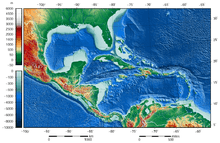
The Caribbean's floor is composed of sub-oceanic sediments of deep red clay in the deep basins and troughs. On continental slopes and ridges calcareous silts are found. Clay minerals likely having been deposited by the mainland river Orinoco and the Magdalena River. Deposits on the bottom of the Caribbean Sea and Gulf of Mexico have a thickness of about 1 km. Upper sedimentary layers relate to the period from the Mesozoic to the Cenozoic (250 million years ago to present) and the lower layers from the Paleozoic to the Mesozoic.
The Caribbean sea floor is divided into five basins separated from each other by underwater ridges and mountain ranges. Atlantic Ocean water enters the Caribbean through the Anegada Passage lying between the Lesser Antilles and Virgin Islands and the Windward Passage located between Cuba and Haiti. The Yucatán Channel between Mexico and Cuba links the Gulf of Mexico with the Caribbean. The deepest points of the sea lie in Cayman Trough with depths reaching approximately 7,686 m (25,220 ft). Despite this, the Caribbean Sea is considered a relatively shallow sea in comparison to other bodies of water.

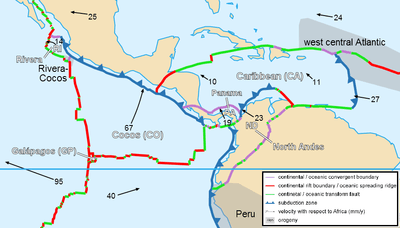
The pressure of the South American Plate to the east of the Caribbean causes the region of the Lesser Antilles to have high volcanic activity. There was a very serious eruption of Mount Pelée in 1902 which caused many casualties.
The Caribbean sea floor is also home to two oceanic trenches: the Cayman Trench and Puerto Rico Trench, which put the area at a high risk of earthquakes. Underwater earthquakes pose a threat of generating tsunamis which could have a devastating effect on the Caribbean islands. Scientific data reveals that over the last 500 years the area has seen a dozen earthquakes above 7.5 magnitude.[8] Most recently, a 7.1 earthquake struck Haiti on January 12, 2010.
Oceanography

The hydrology of the sea has a high level of homogeneity. Annual variations in monthly average water temperatures at the surface do not exceed 3 °C. Over the past fifty years the Caribbean has gone through three stages: cooling until 1974; a cold phase with peaks during 1974-1976 and 1984-1986 then; a warming phase with increase in temperature of 0.6 °C per year. Virtually all temperature extremes were associated with the phenomena of el Niño and la Niña. The salinity of sea water is about 3.6% and its density is 1.0235-1.0240 103 kg/m3. The surface water colour is blue-green to green.
Ecology
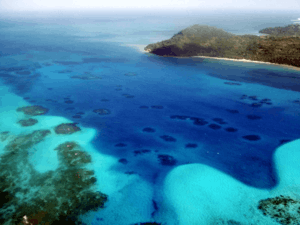
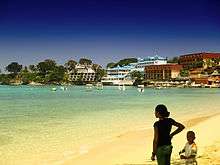
The Caribbean is home to about 9% of the world's coral reefs covering about 50,000 km2 (19,000 sq mi), most of which are located off the Caribbean Islands and the Central American coast.[9] Among them stands out the Belize Barrier Reef with an area of 96,300 ha which was declared a World Heritage Site in 1996. It forms part of the Great Mayan Reef also known as the MBRS and being over a thousand km in length is the world's second longest. It runs along the Caribbean coasts of Mexico, Belize, Guatemala and Honduras.

During the past ten years, unusually warm Caribbean waters have been increasingly threatening Caribbean coral reefs. Coral reefs support some of the most diverse marine habitats in the world, but they are fragile ecosystems. When tropical waters become unusually warm for extended periods of time, microscopic plants called zooxanthellae, which are symbiotic partners living within the coral polyp tissues, die off. These plants provide food for the corals, and give them their color. The result of the death and dispersal of these tiny plants is called coral bleaching, and can lead to the devastation of large areas of reef. Over 42% of corals are completely bleached and 95% are experiencing some type of whitening.[10]
The habitats supported by the reefs are critical to such tourist activities as fishing and diving, and provide an annual economic value to Caribbean nations of $3.1-$4.6 billion. Continued destruction of the reefs could severely damage the region's economy.[11] A Protocol of the Convention for the Protection and Development of the Marine Environment of the Wider Caribbean Region came in effect in 1986 to protect the various endangered marine life of the Caribbean through forbidding human activities that would advance the continued destruction of such marine life in various areas. Currently this protocol has been ratified by 15 countries.[12] Also several charitable organisations have been formed to preserve the Caribbean marine life, such as Caribbean Conservation Corporation which seeks to study and protect sea turtles while educating others about them.[13]
In connection with the foregoing, the Institute of Marine Sciences and Limnology of the National Autonomous University of Mexico, conducted a regional study, funded by the Department of Technical Cooperation of the International Atomic Energy Agency, in which specialists from 11 Latin American countries (Colombia, Costa Rica, Cuba, Guatemala, Haiti, Honduras, Mexico, Nicaragua, Panama, Dominican Republic, Venezuela plus Jamaica) participated. The findings indicate that heavy metals such as mercury, arsenic and lead, have been identified in the coastal zone of the Caribbean Sea. Analysis of toxic metals and hydrocarbons is based on the investigation of coastal sediments that have accumulated less than 50 meters deep during the last hundred and fifty years. The project results were presented in Vienna in the forum "Water Matters", and the 2011 General Conference of said multilateral organization.[14]
Weather
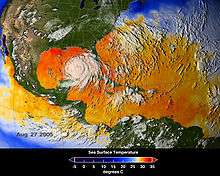
The Caribbean weather is influenced by the Gulf Stream and Humboldt Current ocean currents.[16] The tropical location of the sea helps the water to maintain a warm temperature ranging from the low of 21–26 °C (70–79 °F) by the season.
The Caribbean is a focal area for many hurricanes within the Western Hemisphere. A series of low pressure systems develop off the West coast of Africa and make their way across the Atlantic Ocean. While most of these systems do not become tropical storms, some do. The tropical storms can develop into Atlantic hurricanes, often in the low pressure areas of the eastern Caribbean. The Caribbean hurricane season as a whole lasts from June through November, with the majority of hurricanes occurring during August and September. On average around 9 tropical storms form each year, with 5 reaching hurricane strength. According to the National Hurricane Center 385 hurricanes occurred in the Caribbean between 1494 and 1900.
Every year hurricanes represent a potential threat to the islands of the Caribbean, due to the extremely destructive nature of these powerful weather systems. Coral reefs can easily be damaged by violent wave action, and can be destroyed when a hurricane dumps sand or mud onto a reef. When this happens, the coral organisms are smothered and the reef dies and ultimately breaks apart.
Flora and fauna
The region has a high level of biodiversity and many species are endemic to the Caribbean.
Vegetation
The vegetation of the region is mostly tropical but differences in topography, soil and climatic conditions increase species diversity. Where there are porous limestone terraced islands these are generally poor in nutrients. It is estimated that 13 thousand species of plants grow in the Caribbean of which 6.5 thousand are endemic. For example, guaiac wood (Guaiacum officinale), the flower of which is the national flower of Jamaica and the Bayahibe rose (Pereskia quisqueyana) which is the national flower of the Dominican Republic and the ceiba which is the national tree of both Puerto Rico and Guatemala. The mahogany is the national tree of the Dominican Republic and Belize. The caimito (Chrysophyllum cainito) grows throughout the Caribbean. In coastal zones there are coconut palms and in lagoons and estuaries are found thick areas of black mangrove and red mangrove (Rhizophora mangle).
In shallow water flora and fauna is concentrated around coral reefs where there is little variation in water temperature, purity and salinity. Leeward side of lagoons provide areas of growth for sea grasses. Turtle grass (Thalassia testudinum) is common in the Caribbean as is manatee grass (Syringodium filiforme) which can grow together as well as in fields of single species at depths up to 20 metres. Another type shoal grass (Halodule wrightii) grows on sand and mud surfaces at depths of up to 5 metres. In brackish water of harbours and estuaries at depths less than 2.5 metres widgeongrass (Ruppia maritima) grows. Representatives of three species belonging to the genus Halophila, (Halophila baillonii, Halophila engelmannii and Halophila decipiens) are found at depths of up to 30 metres except for Halophila engelmani which does not grow below 5 metres and is confined to the Bahamas, Florida, the Greater Antilles and the western part of the Caribbean. Halophila baillonii has been found only in the Lesser Antilles.[17]
Fauna
Marine biota in the region have representatives of both the Indian and Pacific oceans which were caught in the Caribbean before the emergence of the Isthmus of Panama four million years ago.[18] In the Caribbean Sea there are around 1,000 documented species of fish, including sharks (bull shark, tiger shark, silky shark and Caribbean reef shark), flying fish, giant oceanic manta ray, angel fish, spotfin butterflyfish, parrotfish, Atlantic Goliath grouper, tarpon and moray eels. Throughout the Caribbean there is industrial catching of lobster and sardines (off the coast of Yucatán Peninsula).
There are 90 species of mammals in the Caribbean including sperm whales, humpback whales and dolphins. The island of Jamaica is home to seals and manatees. The Caribbean monk seal which lived in the Caribbean is considered extinct. The solenodon is endangered.
There are 500 species of reptiles (94% of which are endemic). Islands are inhabited by some endemic species such as rock iguanas and American crocodile. The green iguana and the blue iguana both endemic to the island of Grand Cayman are endangered. The Mona ground iguana which inhabits the island of Mona, Puerto Rico, is endangered. The rhinoceros iguana from the island of Hispaniola which is shared between Haiti and the Dominican Republic is also endangered. The region has several types of sea turtle (loggerhead, green turtle, hawksbill, leatherback turtle, Atlantic ridley and olive ridley). Some species are threatened with extinction.[19] Their populations have been greatly reduced since the 17th century - the number of green turtles has declined from 91 million to 300,000 and hawksbill turtles from 11 million to less than 30,000 by 2006.[20]
All 170 species of amphibians that live in the region are endemic. The habitats of almost all members of the toad family, poison dart frogs, tree frogs and leptodactylidae (a type of frog) are limited to only one island.[21] The Golden coqui is in serious threat of extinction.
In the Caribbean 600 species of birds have been recorded of which 163 are endemic such as the tody, Fernandina's flicker and palmchat. The American yellow warbler is found in many areas as is the green heron. Of the endemic species 48 are threatened with extinction including the Puerto Rican amazon, yellow-breasted crake and the Zapata wren. According to Birdlife International in 2006 in Cuba 29 species of bird are in danger of extinction and two species officially extinct.[22] The black-fronted piping guan is endangered as is the plain pigeon. The Antilles along with Central America lie in the flight path of migrating birds from North America so the size of populations is subject to seasonal fluctuations. In the forests are found parrots, bananaquit and toucans. Over the open sea can be seen frigatebirds and tropicbirds.
Economy and human activity

The Caribbean region has seen a significant increase in human activity since the colonisation period. The sea is one of the largest oil production areas in the world, producing approximately 170 million tons per year.[23] The area also generates a large fishing industry for the surrounding countries, accounting for half a million metric tons of fish a year.[24]
Human activity in the area also accounts for a significant amount of pollution, The Pan American Health Organization estimated in 1993 that only about 10% of the sewage from the Central American and Caribbean Island countries is properly treated before being released into the sea.[23]
The Caribbean region supports a large tourist industry. The Caribbean Tourism Organization calculates that about 12 million people a year visit the area, including (in 1991–1992) about 8 million cruise ship tourists. Tourism based upon scuba diving and snorkeling on coral reefs of many Caribbean islands makes a major contribution to their economies.[25]
Popular culture
The Caribbean is the setting for countless literary efforts often related to piracy acts and swashbuckling. One memorable work of pulp fiction has in its title a geographic feature unique in its way to the islands: Fear Cay, the eleventh Doc Savage adventure by Lester Dent. Many James Bond adventures were set there. All of the action of the Monkey Island series videogames takes place within the Caribbean Sea area. It is also well known as the location of the Pirates of the Caribbean films, featuring Port Royal. Less swashbuckling, but not lacking in man-against-the-sea exploits, is Peter Matthiessen's Far Tortuga (1975), which chronicles the adventures of a turtling crew in the late 1960s.
The video game series Assassin's Creed features the Caribbean as an important place in its timeline. For example, Assassin's Creed IV: Black Flag, along with its Freedom Cry DLC, entirely takes place in the Caribbean Sea, while some events also occur in the Caribbean in Assassin's Creed III to stop further British expeditions during the American Revolutionary War.
See also
Gallery
-

Cayo de Agua in Los Roques archipelago, Venezuela
-
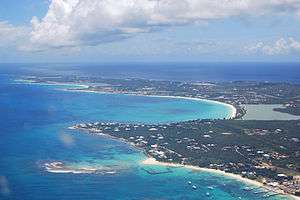
The Anguilla island.
-
Sunrise over the south beach of Jamaica
-
Scotts Head, Dominica
References
- ↑ The Caribbean Sea All The Sea. URL last accessed May 7, 2006
- ↑ "Mesoamerican Reef | Places | WWF". World Wildlife Fund. Retrieved 2016-10-21.
- ↑ Gorgas, William C. (1912). "Sanitation at Panama". Journal of the American Medical Association. American Medical Association. 58: 907. doi:10.1001/jama.1912.04260030305001. ISSN 0002-9955. Retrieved 2015-07-22.
The Pacific Ocean, south of this isthmus [Panama], was known to the early explorers as the South Sea, and the Caribbean, lying to the north, as the North Sea.
- ↑ "Limits of Oceans and Seas, 3rd edition" (PDF). International Hydrographic Organization. 1953. Retrieved 7 February 2010.
- ↑ Iturralde-Vinent, Manuel (2004), The first inhabitants of the Caribbean , Cuban Science Network . URL accessed on 28/07/2007
- ↑ National Geophysical Data Center, 1999. Global Land One-kilometer Base Elevation (GLOBE) v.1. Hastings, D. and P.K. Dunbar. National Geophysical Data Center, NOAA. doi:10.7289/V52R3PMS [access date: 2015-03-16]
- ↑ Amante, C. and B.W. Eakins, 2009. ETOPO1 1 Arc-Minute Global Relief Model: Procedures, Data Sources and Analysis. NOAA Technical Memorandum NESDIS NGDC-24. National Geophysical Data Center, NOAA. doi:10.7289/V5C8276M [access date: 2015-03-18].
- ↑ Dawicki, Shelley. "Tsunamis in the Caribbean? It's Possible.". Oceanus. Retrieved April 30, 2006.
- ↑ Status of coral reefs in the Caribbean and Atlantic Ocean Archived June 21, 2006, at the Wayback Machine. World Resource Institute. URL accessed on April 29, 2006.
- ↑ Inter Press Service News Agency - Mesoamerican Coral Reef on the way to becoming a Marine Desert
- ↑ Alarm sounded for Caribbean coral. BBC News. URL accessed on April 29, 2006.
- ↑ Protocol Concerning Specially Protected Areas and Wildlife to the Convention for the Protection and Development of the Marine Environment of the Wider Caribbean Region (SPAW) NOAA Fisheries: Office of Protected Resources. URL accessed on April 30, 2006.
- ↑ Caribbean Conservation Corporation Archived October 1, 2006, at the Wayback Machine. Orion Online. URL last accessed May 1, 2006.
- ↑ Analysis of Contaminants in the Caribbean Sea over the last 150 years. National Autonomous University of Mexico (UNAM) 2012 (Spa).
- ↑ NASA Satellites Record a Month for the Hurricane History Books
- ↑ Silverstein, Alvin (1998) Weather And Climate (Science Concepts); page 17. 21st Century. ISBN 0-7613-3223-5
- ↑ Caribbean seagrass. Seagrass watch, retrieved April 23, 2009.
- ↑ Robert James Menzies, John C Ogden. "Caribbean Sea". Britannica Online Encyclopaedia.
- ↑ Severin Carrell, "Caribbean Sea Turtles Close to Extinction", The Independent, 28 November 2004.
- ↑ Historic Caribbean Sea Turtle Population falls 99%. Plunge has significant ecological consequences. Mongabay.com (August 1, 2006).
- ↑ Conservation International Caribbean Islands, Threatened Species.
- ↑ "Birdlife International" - Red List Cuba.
- 1 2 An Overview of Land Based Sources of Marine Pollution Caribbean Environment Programme. URL last accessed May 14, 1 B.C.
- ↑ LME 12: Caribbean Sea NOAA Fisheries Northeast Fisheries Science Center Narragansett Laboratory. URL last accessed May 14, 2006.
- ↑ Reefs at Risk in the Caribbean: Economic Valuation Methodology World Resources Institute 2009.
Further reading
| Wikimedia Commons has media related to Caribbean Sea. |
- Snyderman, Marty (1996), Guide to Marine Life: Caribbean-Bahamas-Florida, Aqua Quest Publications, pp. 13–14, 19. ISBN 1-881652-06-8
- Glover K., Linda (2004), Defying Ocean's End: An Agenda For Action, Island Press, p. 9. ISBN 1-55963-755-2
- Peters, Philip Dickenson (2003), Caribbean WOW 2.0, Islandguru Media, p. 100. ISBN 1-929970-04-8
- Reefs at Risk in the Caribbean: Economic Valuation Methodology, World Resources Institute 2007.
External links
Coordinates: 15°N 75°W / 15°N 75°W




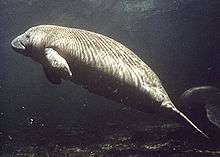




.jpg)